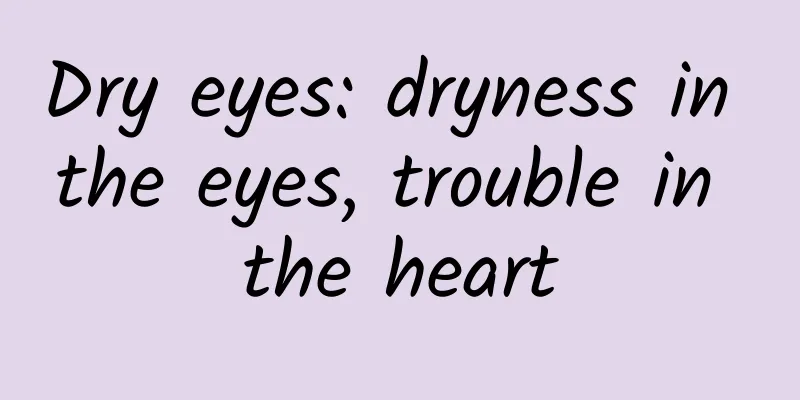Dry eyes: dryness in the eyes, trouble in the heart

|
Dry eye is one of the most common eye diseases in life. It has symptoms such as dry eyes, itchy eyes, and foreign body sensation in the eyes. It has been called "office syndrome", "keratoconjunctivitis sicca", and "dry eye syndrome" [1]. With the deepening of understanding at home and abroad, the disease was officially named "dry eye" at an international conference in 2007 [2]. Dry eye has many pathogenic factors, a long pathogenic and treatment process, an imbalance of the ocular surface microenvironment, and may be accompanied by abnormalities of the ocular surface sensory nerves, causing eye discomfort [1]. Dry eye can easily cause great trouble to patients' daily life and work. Studies have shown that the prevalence of sleep and emotional disorders in patients with dry eye is significantly higher than that of healthy people [2]. Therefore, helping ordinary people understand dry eye and the treatment goals and plans for dry eye can help build confidence for patients and improve their quality of life. When treating dry eyes, ophthalmologists will provide long-term and individualized treatment according to the different types and degrees of dry eyes, and help patients adapt to the chronic disease management system [3]. Next, let us briefly understand the classification of dry eyes: according to the main components or functional abnormalities of tears, dry eyes can be divided into five categories: aqueous deficiency type, lipid abnormality type, mucin abnormality type, tear dynamics abnormality type and mixed type; and according to the severity of dry eye signs and examination results, dry eyes can be divided into mild, moderate and severe [1]. For patients with mild and moderate dry eyes, since the disease is reversible, the goal of treatment should be to relieve symptoms while eliminating the cause as much as possible and protecting visual function; however, the cause of severe dry eyes is more complex and most of them are irreversible. Therefore, the goal of treatment for severe dry eyes is to protect visual function and relieve the discomfort caused by dry eyes on the basis of treating the primary disease [3]. I believe that people who have come into contact with eye diseases are familiar with the term "artificial tears". Dry eye patients have problems such as incomplete tear film and reduced tear secretion, so artificial tears are also the first-line medication for the treatment of dry eyes. As a symptomatic treatment, the main function of artificial tears is to replace or supplement one or more layers of the tear film to lubricate the ocular surface[2]. Mild dry eye patients are suitable for low-viscosity artificial tears, such as 0.1% sodium hyaluronate, polyethylene glycol, etc., and the frequency of use is 4 times a day; moderate and severe dry eye patients are suitable for high-viscosity artificial tears, such as 0.3% sodium hyaluronate, polyacrylic acid, etc., and the frequency of use is appropriately increased or used on demand[3]. It should be noted that for people who use artificial tears for a long time and frequently (such as more than 6 times a day), preservative-free drugs should be preferred. Eye gels and ointments stay on the ocular surface for a long time, but because they can cause blurred vision and eye discomfort, it is recommended to use them before bed[3]. At the same time, patients are advised to use high-viscosity eye drops at night when sleeping and low-viscosity eye drops during the day to improve the comfort of the ocular surface [2]. In addition to drug treatment, diet and nutritional supplements can also play a role in the treatment of dry eyes, including adequate water intake and supplementation of essential fatty acids. Clinical data show that supplementation of ω-3 unsaturated fatty acids can improve the tear film breakup time and tear secretion volume of patients, but this drug is not suitable for patients with atrial fibrillation, liver disease and bleeding diseases [2]. 【References】 [1] Asian Dry Eye Association China Chapter, Ocular Surface and Tear Disease Group of the Ophthalmology Committee of the Cross-Strait Medical and Health Exchange Association, Ocular Surface and Dry Eye Group of the Ophthalmology Branch of the Chinese Medical Doctor Association. Chinese expert consensus on dry eye: definition and classification (2020) [J]. Chinese Journal of Ophthalmology, 2020, 56(6): 418‑422. [2] Jones L, Downie LE, Korb D, et al. TFOS DEWS Ⅱ management and therapy report [J]. Ocul Surf, 2017, 15(3): 575-628. [3] Asian Dry Eye Association China Chapter, Ocular Surface and Tear Disease Group of the Ophthalmology Committee of the Cross-Strait Medical and Health Exchange Association, Ocular Surface and Dry Eye Group of the Ophthalmology Branch of the Chinese Medical Doctor Association. Chinese Expert Consensus on Dry Eye: Treatment (2020) [J]. Chinese Journal of Ophthalmology, 2020, 56(12): 907-913. |
>>: Do you need to wash off the hair oil? When should you use the hair oil?
Recommend
What are the symptoms of uterine fibroids?
Anyone with a little medical knowledge knows that...
One finger, one life, worth it!
I was in the operating room doing a hand injury w...
Is the early or late fetal movement affected by gender? What affects the early or late fetal movement?
We all know that fetal movement is a common sympt...
Can I drink saffron if I have uterine fibroids?
Uterine fibroids are a symptom of tumors. Patient...
How long should I rest after a miscarriage in one month of pregnancy?
After an abortion, you must pay attention to rest...
Can I have a blood test during my period?
Many ladies have checkups during their menstrual ...
Will my stomach hurt when I first get pregnant?
When a woman becomes pregnant, some changes will ...
What causes vulvar itching and vaginal bleeding?
Generally, women will not take it seriously when ...
Why do pregnant women have dark nipples?
Some women experience many changes in their bodie...
Is it normal to have less fetal movement in the eighth month of pregnancy?
When the mother is eight months pregnant, she wil...
Can pregnant women take stomach-strengthening and digestion-promoting tablets?
Many pregnant women will feel loss of appetite in...
Say goodbye to thick glasses, a girl with 700-degree myopia cured her myopia without surgery
Xiaoyou (pseudonym), a girl with 700-degree myopi...
Why does a woman have pain in the lower left side of her belly button?
If a woman experiences pain in the lower left are...
Detailed explanation of the benefits of sex life for menopausal women!
Many women will subconsciously avoid sexual life ...
What causes bleeding after sex?
Some people experience bleeding after having sex....









